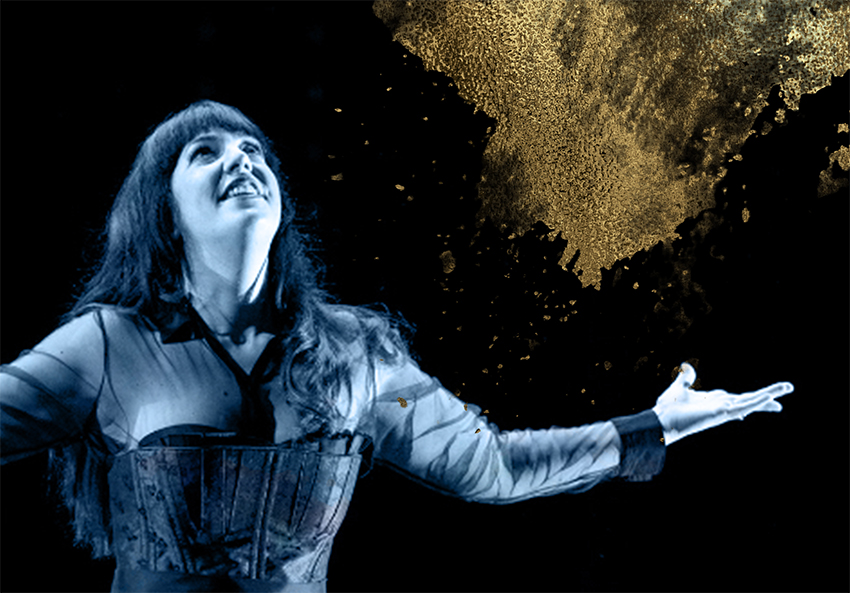10 July 2024 | NEWS
Elite has ventured into the world of music with Elite Lullabies – our first album, with plenty of atmosphere amid these well-known, historical lullabies interpreted by equally well-known Swiss musicians. Here we take a peek behind the scenes of this delicate, graceful and ambitious project.
Five fabulous covers
Five of the best contemporary musicians took up our invitation to give their take on a legendary lullaby and tell us about the origins of these relaxing tunes.
Brahms’ Wiegenlied
JULIE CAMPICHE, harpist and composer, French-speaking Switzerland

How would you describe your musical style?
I work mainly in jazz and contemporary music.
What does the word ‘lullaby’ conjure up for you?
Three things: gentleness, love, and feeling safe.
How did you go about making your version for Elite Lullabies?
To develop a concept based on Brahms’ Wiegenlied, I imagined myself putting my daughter to bed and sought to reproduce my feelings using these musical building blocks.
Do you manage to strike a balance between your work as an artist and your sleep requirements?
I love sleeping, but find it very hard to actually decide to go to bed!
My work and family life mean that I don’t have anything like a regular schedule. Sometimes I go to bed very late and have to get up very early. If I do, I take a nap to catch up during the afternoon; but that’s fine with me.
« À la claire fontaine »
RÉGIS, composer, singer and songwriter, Geneva

How would you describe your musical style?
I’d describe it as ‘eromantic’ pop!
What does the word ‘lullaby’ conjure up for you?
The comforting sound of mummy and daddy’s voices.
How did you go about making your version for Elite Lullabies?
In bed of course (laughter)! Not really: for this project, I worked with musician Christophe Calpini.
Do you manage to strike a balance between your work as an artist and your sleep requirements?
It’s difficult right now as we have a new baby...
I’m sure I’ll find a good sleep pattern eventually!
« Ah ! Vous dirai-je maman »
CAMILLE BERTHOLLET, composer and songwriter, France/Switzerland

How would you describe your musical style?
I play the violin and cello, and enjoy both classical and crossover music.
How do you reconcile the need for sleep with your work as an artist?
I’m very often travelling or on tour, so sleep quality is extremely important to me.
What does the word ‘lullaby’ conjure up for you?
The untroubled world of childhood.
How did you go about making your version for Elite Lullabies?
I approached this project by writing an arrangement of Mozart’s Ah ! Vous dirai-je maman designed to create an atmosphere of calm and recall the innocence of childhood.
« Au clair de la lune »
NOA R, singer-songwriter

How would you describe your musical style?
Most of what I sing is basically French mainstream pop, but I do venture into other styles as well. For me the most important thing is for what I sing to have an emotional impact on me, and for me to be able to pass on that impact.
What does the word ‘lullaby’ conjure up for you?
Something soft and magical that brings calm and carries us off into dreamland.
How did you go about making your version for Elite Lullabies?
Au clair de la Lune is the first lullaby I remember.
I wanted to cover it in a Disneyfied style to give it a really magical, fairytale vibe.
How do you reconcile the need for sleep with your work as an artist?
I often listen to music as I go to sleep. When I’m travelling for work, I try to sleep as much as I can on the road to catch up on my sleep and be in good shape to perform. I generally listen to music and let myself drift off. Concert schedules mean my sleep schedule is often all over the place!
« Fa la ninna, fa la nanna »
MARINA VIOTTI, mezzosoprano opera singer, Vaud

How would you describe your musical style?
I’m an opera singer.
What does the word ‘lullaby’ conjure up for you?
I see lullabies as a way of slowing down the heartbeat and drawing us into the right mood for sleep and dreams. ‘Nanna’ was the lullaby my Italian grandmother used to sing to me as I went to sleep.
How did you go about making your version for Elite Lullabies?
I decided to add a lute part to this traditional Venetian song.
Well-known lullabies with little-known histories
Lullabies have been helping babies go to sleep since time memorial. They’ve been passed down to us, and now it’s our turn to pass them on. They’re probably the first love songs children ever hear. Everybody knows them, but their origins are often a mystery.
Au clair de la lune
Although this is undoubtedly the best-known French lullaby, its origins remain unknown. The song was first recorded in 1860, by Edouard-Léon Scott de Martinville; this is the oldest known recording of a human voice. It’s thought that the first version of the lyrics was written by a certain Théophile Marion Dumersan in 1843. Au clair de la lune has frequently been covered by popular French artists, among them Charles Trenet, France Gall and Colette Renard.
À la claire fontaine
This enigmatic lullaby is one of the best-known of all, epitomising the French nursery rhyme for people all over the world. It’s to be found as far afield as some Japanese TV cartoons, including an episode of Heidi, Girl of the Alps. Ethnomusicologist Marius Barbeau believes that À la claire fontaine was probably composed by a travelling minstrel sometime between the fifteenth and sixteenth centuries to accompany words written by an anonymous fifteenth-century poet.
Fa la ninna, fa la nanna
This generic title refers to a timeless Italian lullaby sung and whistled the world over. Rather than being the title of a single piece of music, Fa la ninna, fa la nanna denotes a popular tune found in every region of Italy ever since the Middle Ages. More recently, well-known film composer Ennio Morricone wrote his own version of Ninna Nanna, thus popularising a melody whose origins remains shrouded in history.
Berceuse de Brahms
Also known as Good Evening, Good Night, as its name suggests Brahms’ Wiegenlied was composed by the famous German composer Johannes Brahms and published for the first time in 1868. The lullaby is a two-verse piece of classical music known throughout the globe. Quebecoise singer Céline Dion offered her own rendition on her 2004 concept album featuring lullabies.
Ah ! Vous dirai-je maman
The melody of this light-hearted children’s song was popularised in 1781 with Wolfgang Amadeus Mozart’s ‘Twelve Variations’, based on a tune published in 1761 in Francis Bouin’s Vielleuse habile method to teach the hurdy-gurdy. The original words were a parody of a love poem of unknown origin entitled La Confidence (‘the secret’). Dozens of different versions have been written worldwide since the eighteenth century in languages including Portuguese, English, German and even Vietnamese.


